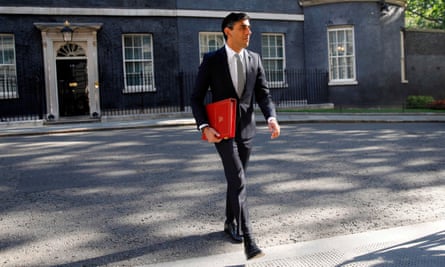UPDATED
Furloughed workers three times as likely to default on a payment
Consumer group finds 6% have missed loan or credit card payment in sign of impact of coronavirus

Published onMon 3 Aug 2020
Furloughed workers are three times more likely than other employees to have defaulted on a payment last month, in a sign of the economic distress caused by the Covid-19 pandemic.
As the UK government started unwinding the furlough operation that has paid millions of workers 80% of their salary, a survey by Which? has found that those still relying on the scheme are starting to feel the financial heat.
The consumer group found that 13% of those furloughed, put on enforced leave or reduced hours due to the coronavirus crisis, have defaulted on at least one payment, compared with 4% of those still working as normal.
Between 3 million and 5 million workers are still thought to be having all or some of their wages paid through the Treasury-backed scheme. Which? said 6% of workers on the scheme reported that they has missed a loan or credit card payment in the previous four weeks.
Of those with a mortgage or renting, 5% had already defaulted on a housing payment – twice the default rate for the normally working population. Some respondents will have defaulted on more than one payment type in the last month, it said.
If the survey is representative, it would mean that as many as 500,000 workers missed a payment.
At the start of the crisis, the Financial Conduct Authority ordered the banks and other loan providers to offer mortgage payment holidays as well as similar assistance for credit cards, personal loans, car finance, payday loans, overdrafts and insurance premiums.
The FCA measures are set to wind up at the end of October, which is also the day the furlough scheme is halted.
The fear is that workers whose jobs have been completely underwritten by it will be axed as employers realise that they must start contributing.
Since last Saturday, companies had to start paying national insurance and pension contributions for furloughed staff, as part of its phased removal. So far the scheme has cost the taxpayer more than £31bn.
Richard Piggin, the head of campaigns at Which?, said: “Despite extensive action being taken by the government and the banking industry, it’s very worrying that people currently on the furlough scheme have reported experiencing much higher levels of financial difficulty than those who are working as normal.
“With just a couple of months until the scheme comes to an end, there is real concern that this gap could widen even further. The Financial Conduct Authority will also have to ensure consumers are provided with the help they need if they are in financial difficulty.”
Last week, the biggest banks warned that their profits would be hit as customers failed to pay back loans. Lloyds, the UK’s biggest bank, was putting aside £2.4bn for bad debts, saying the economic impact of the Covid-19 lockdown was “much larger than expected”.
The Resolution Foundation thinktank has said that up to half of all workers in the hard-hit hospitality and leisure sectors were likely still to be on furlough, raising concerns about the impact of across-the-board increases to employer contributions.
Extending the furlough scheme would cost little – and benefit the whole of the UK
Keeping the lifeline until June 2021 would cost £10bn. But it would also save a million jobs and help growth, our research shows
• Garry Young is deputy director of the National Institute for Economic and Social Research
• Garry Young is deputy director of the National Institute for Economic and Social Research

Published onTue 4 Aug 2020
The government’s furlough scheme – known formally as the coronavirus job retention scheme – has been an undoubted success. It has kept unemployment down despite a deep contraction of around a quarter in what the economy produces. It has directly helped protect 9.5m jobs and been a lifeline for those employees who would otherwise have suffered a loss of income and worried about their future.
The furlough scheme has not been cheap and has contributed to the dramatic rise in government borrowing. But it has undoubtedly saved the economy from far greater damage. Which makes it so frustrating that the chancellor plans to close it in October, long before most people believe the effect of the pandemic will be over.
The number furloughed will fall over the next few months as the economy starts to return to normal in many sectors. Employers are already recalling workers: according to an ONS survey, the proportion of employees on furlough fell from 32% at its peak to 18% in the first half of July. We estimate that between 5 and 6 million people are still on furlough leave. Between 1 and 1.5 million people are likely to be made unemployed when the furlough scheme ends in October, according to our modelling.
Unemployment can obviously be devastating on a personal level but it also has lasting economic consequences. Those who are out of work may become “disengaged” from the labour market. They may lose skills they had in work and fail to gain new ones. Relationships between employers and employees that have been built up, in some cases over decades, may be lost and never replaced, with adverse consequences for the economy as a whole.
That doesn’t mean the government should pay people to stay off work indefinitely – but it does mean looking at what can be done to preserve viable jobs until the pandemic is over.
Of course, keeping the furlough scheme going comes at a cost, but it also has benefits. After all, that is why the government introduced it in the first place. So what would happen if the government extended the scheme until the middle of next year, when a vaccine may be available? The direct cost would be the cost to the government of paying the wages of those who remained furloughed. But this would be offset by the income tax and national insurance contributions paid on the wages of those remaining on furlough – and savings on unemployment benefits that would not need to be paid. That would mean that the net cost of extending the furlough scheme would be around £10bn.
Not only would unemployment be lower next year – around 2 million instead of more than 3 million – we estimate it would remain lower at least until 2024, benefiting the private sector throughout the recovery as people have more money and more confidence about their futures. This would help economic growth and, according to our estimates, actually leave public sector debt slightly lower as a share of GDP than if the scheme were to be closed in October.
Without an extension, unemployment is likely to near 10%. For some parts of the UK, especially in the south and east of England, jobless numbers could be higher than they were during the global financial crisis, or the early-1990s recession.
Rishi Sunak has said that the furlough scheme should be a “bridge” through the pandemic. By withdrawing furlough support prematurely, he risks building a bridge that does not reach the other side. Finishing the job would cost little and benefit all of us.
No comments:
Post a Comment